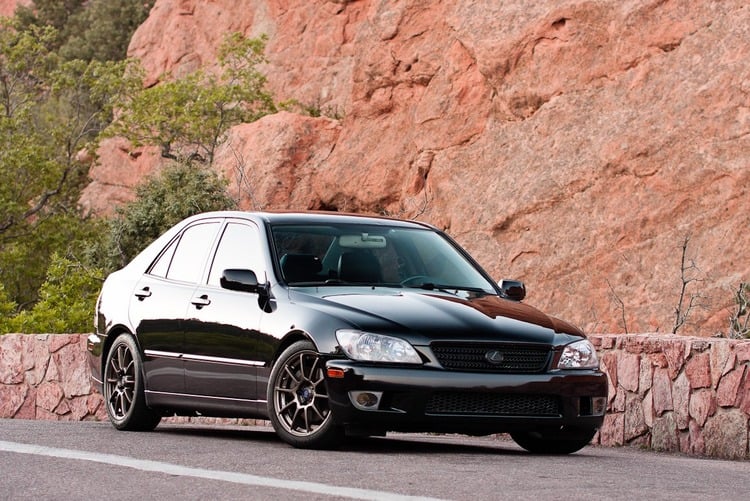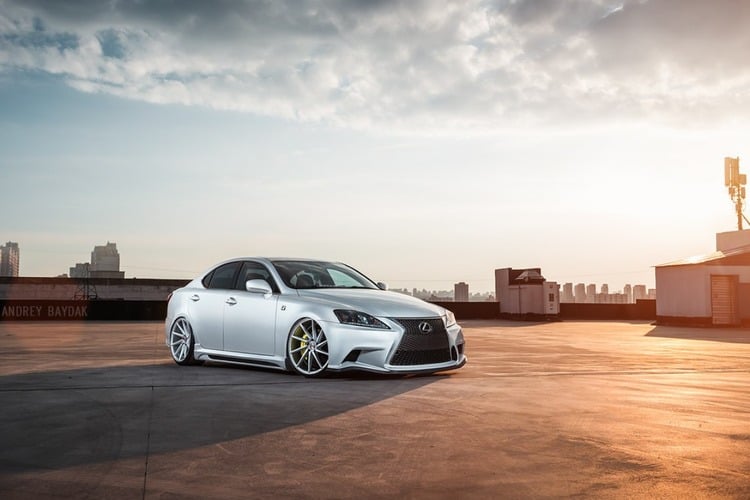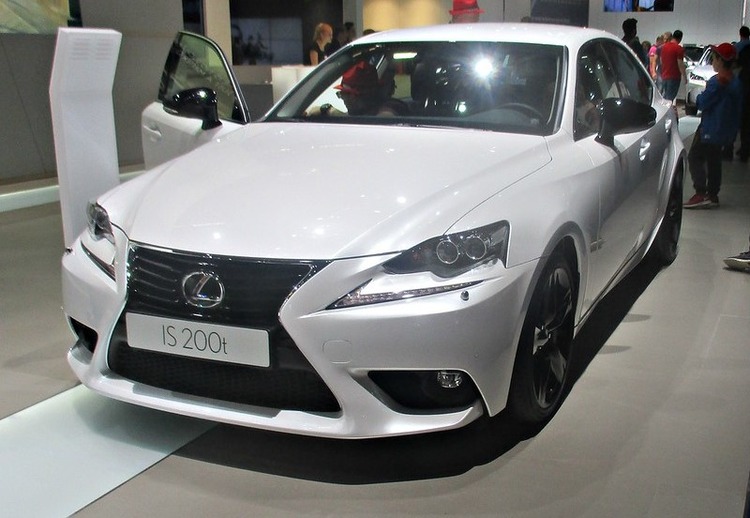Lexus IS300 – The Japanese 3-Series?
Bringing the JDM coolness to the luxury car market, the tail-happy IS300 has become a popular choice among drifters – is it right for you?

Jump To Section
Introduction
Japanese automobile giant Toyota’s luxury car division, Lexus, has seen a lot of success with its IS300. The IS badge on Lexus stands for “Intelligent Sport.”
The Lexus IS300 is the up-spec sportier, more luxurious USDM version of its JDM sibling – the Toyota Altezza.
The rear-wheel drive sports sedan has been a sales triumph for Lexus and has increasingly gained popularity since its launch in 1999.
Production for the model continues to date, and the car has seen three generations since its launch.
Lexus was commonly known for its luxury, but with IS300’s launch, it entered into the niche market of luxury sports sedans, with more emphasis on performance.
The Lexus IS offers great sporty sound, looks, and driving posture, which is good enough to impress youngsters who need new automobiles.
Lexus engineers tested the IS300 in Germany, comparing top-performance sedans on the Nurburgring course.
The end product is a muscular 3-series rival with a class-leading 215 horsepower.
Lexus IS300 History
The Lexus IS300 was a direct competitor to the BMW 3 Series. BMW lost its edge in the luxury sports sedan segment due to Toyota Motors’ premium car division, Lexus.
The BMW 3 Series had set the standard for the type for over two decades, making the model available as a sedan, coupe, ragtop, and station wagon.
The IS300 filled the market gap upon its launch. Performance figures of the IS300 greatly matched the 3 series spec sheet.
The first generation IS was one-tenth of an inch shorter, one-tenth of an inch lower, and eight-tenths narrower than the BMW 328Ci.
Some other features of the IS common with the Beemer included 17-inch wheels, twin control arms at all four corners, an inline six-cylinder engine, and rear-wheel drive.
Finally, the IS was positioned to bridge the gap between the entry-level BMW 323 at $29,000 and the opulent 328Ci at $34,000, with a price base of $31,000, at the time of its launch.
Lexus IS300 Variants
The first generation, the XE10 series, made its debut in the Japanese market in 1998 as the Toyota Altezza.
Lexus sold the model as the IS200, a 2.0-liter entry-level luxury sports sedan in the European market. On the other hand, the car was launched in the North American market as the IS300, code name JCE 10, in 2000.
The first-generation models offered two body styles: sedans and station wagons with a SportCross badge, commonly known as the Gita. Straight-six engines powered both variants.

Production for the first-generation models ended in 2005, when the second generation, the XE20, was introduced with V6-powered engines for the sedans, the IS250 and IS350.
In 2007, the second generation of the IS also saw the launch of its signature high-performance F Sport version of the sedan, powered by a very powerful V8 engine. Coupe convertible variants came out later in 2008 as the IS250 C and IS350 C.
The current and third generation of the Lexus IS came out in early 2013 and offered the most variants out of all the IS generations.
The third-gen IS came with a hybrid engine for the first time, the IS300h, the standard V6-powered IS250 and IS350, and a performance F Sport model. This generation also saw turbocharged engines in the IS200t and IS300t.
Powertrain & Specifications
BMW had mastered the art of manufacturing a tiny vehicle that drove like a quick, unflappable tank with the 3 Series.
Since the Lexus IS300 is a direct competitor, it is only fair to compare the performances of both cars.
Even though the Lexus IS300 weighs 70 pounds more than the BMW 3 series, it feels nimble and extremely maneuverable while driving.
When you enter the spacious cabin of the IS300, you immediately notice the captivating charm of its interior. It is a delight to drive the car. The IS 300 has a top speed of 144 mph.
XE10
The first generation IS300 was powered by a 2JZ-GE 3.0-liter straight-six engine producing 215 horsepower and 295 Nm of torque, which was 20 horsepower more than the BMW 328 of that time.
Lexus claims the car can accelerate from 0 to 60 mph in just over seven seconds, with a top speed of 144 mph.

The IS300 offered a 5-speed manual and a 5-speed automatic transmission for sedans, whereas the SportCross station wagon only came with a 5-speed automatic transmission.
The automatic transmission sedans had paddle shifters and a great power-to-weight ratio.
The car had a very quirky chronograph-style gauge cluster that the owners loved!
The IS300 and 3 Series are extremely similar in terms of dimensions. However, the BMW had a 50 mm longer wheelbase than its Japanese rival, which resulted in a smaller backseat area.
IS300 has front, and rear axles set more than two inches closer than the BMW’s, and that double-knuckles’ worth of wheelbase translates into completely different driving characteristics for the two cars.
Despite its impressive power, the biggest difference between the IS300 and BMW 328 appears in a small but crucial detail.
The wheelbase remained the same at 2670 mm for both IS300 variants. Both variants had almost the same dimensions; the sedan had a width of 1720 mm, just 5 mm shorter than the SportCross, and a length of 4400 mm, just 15 mm more concise than the SportCross.
Ride height remained the same at 1410 mm. The IS300 sedan had a curb weight of just under 1500 kg, while the SportCross weighed 1547 kg.
The Lexus has double wishbone suspension at each corner and standard 17-inch wheels.
Its torquey engine performance and sharp handling were the two things that people loved about the car.
The IS300 requires stiffer springs since it understeers excessively in tight bends.
The IS 300 came out as a worthy opponent to the German luxury sports sedans of that time, as it offered all these features at a competitive price.
XE20
Launched in 2005 at the Geneva Motor Show, the second generation IS had many variants, including the sedan and F Sport, and the facelift models also had convertibles.
The IS300 sedan had a 3GR-FE 3.0L V6 engine coupled with a 6-speed automatic transmission, and it produced 228 horsepower and 300 Nm of torque.

The IS300 C coupe came with the same engine and power figures as the sedan.
F Sport versions had the mighty 2UR-GSE 5.0L naturally aspirated V8 engine with an 8-speed automatic transmission and produced 416 horsepower and 503 Nm of torque.
The wheelbase remained the same across all variants at 2730 mm, while other dimensions varied.
XE30
The third generation IS was introduced at the Paris Auto Show for the first time in 2012, and it’s the generation that continues to date, obviously with a massive facelift that it received for the 2020 model year.
With this, the IS300 came with an AWD drivetrain and a hybrid variant for the first time in its third generation.
The standard IS300 sedan comes with Toyota’s new 8AR-FTS 2.0L turbocharged engine, producing 241 horsepower and 350 Nm of torque. It has an 8-speed Sports Direct Shift automatic transmission.

The engine belongs to the four-cylinder AR engine family. It is a turbocharged, direct-injected gasoline-powered engine.
When combined with an electric motor for the IS300 hybrid variant, the 2.5 L 2AR-FXE generates 220 horsepower and 221 Nm of torque, coupled with an electronic CVT gearbox.
The engine made its debut in the 2015 Lexus NX 200t. It was the first in a new line of engines from Toyota that used direct injection, cylinder heads with integrated exhaust manifolds, and enhanced turbocharger management to improve fuel economy greatly.
Although the engine shares many characteristics with the normally aspirated direct-injection 6AR-FSE engine, it also has several special qualities and distinctions.
The AWD variant comes with Toyota’s 2GR-FSE 3.5 L V6 engine, impressive power figures of 306 horsepower and 375 Nm of torque, and a 6-speed super ECT transmission.
Dimensions generally remained the same across the variants, with the wheelbase fixed at 2800 mm. The pre-facelift models were 4665 mm in length, 1810 mm in width, and 1430 mm in height.
The current model, or the facelift model, has a length of 4710 mm, a width of 1840 mm, and a height of 1440 mm, making it slightly bigger dimensionally than the early third-generation models.
Why Is The IS300 So Popular In The United States?
Upon its launch, Lexus adopted a very aggressive advertising campaign for the IS models, which included creative and interactive platforms. More than 180,000 people visited Lexus’ website when the IS 300 was launched.
More than 2,000 people responded to its “Sufficiently Radical Contest,” which asked participants to make 30-second ads for the automobile using a simulated online “studio” to put together a variety of provided stock material, audio, and video.
However, website hits do not equal purchases. As advertised, the IS300 is a genuine alternative to the 3 Series, but is it “sufficiently radical”?
Lexus played a blinder by announcing that it would only import 25,000 vehicles in its first year of sales in the United States and aimed to sell roughly the same number of vehicles as BMW sold in Santa Monica over a weekend. This somehow ended up creating hype for the car.
IS300 Mods, Upgrades & Tuning
The first generation IS300 came with an exciting optional tuning package from the factory.
Known as the L-Tuned Lexus IS 300, it was a limited-edition version of Lexus’ sportiest sedan.
Think of it as a notch or less extreme than the Mercedes-Benz AMG and BMW’s M cars.

Two options were offered: the Series I package, at $3999 above the original price, had a 6-piece body kit and a high-performance exhaust that added 8 horsepower to the IS300’s 215-hp 3.0-liter engine.
The Series Il, at $7698 above the original price, added lightweight 18-inch wheels.
These cars came with Michelin Pilot tires, a lower suspension with firmer progressive-rate springs, and larger anti-sway bars at the front and rear.
Standard IS300s make a nicely balanced handler out of the box, but the L-Tuned has a sports car immediacy to every input.
The Lexus IS300 has always been a popular model among tuners and drifters. Marshall Woolford, a sound engineer, and Soundstream Dealer, claim that he tried to integrate the most well-known aftermarket sound brands on his Lexus.
He developed a build corresponding to the audio type and the import scene. He contacted some of the greatest names in the business, and after three months of hustle, the manufacturers chosen for the project were on board with the idea, and it became a success.
Generally, some of the best IS300 upgrades will increase horsepower to roughly 210 for e-shifts and 230 for manual transmission models. A turbocharger is recommended if you plan to surpass these power figures because maintaining natural aspiration can be expensive.
A stroker kit, meth injection, an aggressive tune, and perhaps even some nitrous might be needed.
More combustion is required to generate more power. Therefore, one of the simplest modifications you can make to your IS300 is an improved air intake. Even though a stock IS300 won’t gain much performance from installing an intake, it will when the other modifications are made.
One of the greatest stand-alone modifications for the 2JZ-GE engine is the installation of exhaust headers.
Headers are a wonderful modification; they are reliable and aid in lowering the engine and exhaust gas temperatures.
In the IS300, catalytic converters are housed in both the headers and the Y-pipe. The removal of both of these cats will result in the greatest power improvements because they are mostly responsible for the limitation.
The most innovative modification is an improved exhaust cam gear. An exhaust cam gear on the 2JZ-GE engine regulates the timing of the exhaust valve.
The adjustable cam gears can also help the car with the standard camshaft with bolt-on modifications. As the original ECU tune isn’t designed for better airflow, tuning the ECU serves as a significant performance upgrade.
Reliability
Another reason for its popularity is that these cars are generally very reliable, like most Japanese cars with Toyota engines.
However, the car has some common known faults, including a hesitation between throttle and transmission engagement.
The radiators that used plastic tubing cracked around the neck. There was a common problem of air coming into the cooling system.
Also, an AC servo failure that caused a clicking sound in the dash was a common problem in the earlier models.
Conclusion
Whenever you talk about exciting rear-wheel drive and drift-friendly cars that offer great driving pleasure with reliability, the Lexus IS300 never fails to be mentioned in the list. This is why it’s often compared to the 3-series.
Whether it’s the latest generation on sale or one of the early models with many exciting modification options to offer as well as the exciting SportCross Wagon, the IS300 remains one of the favorites among car enthusiasts and the drifting community.






















